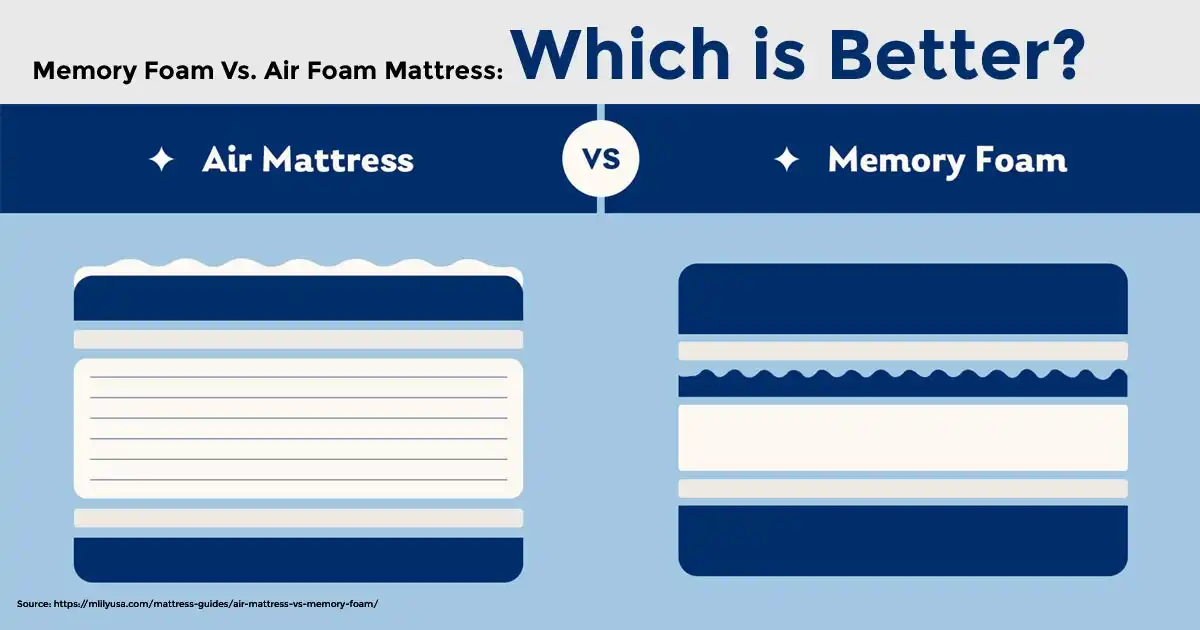Memory Foam Vs. Air Foam Mattress: Which is Better?

Choosing a good mattress may seem challenging. It particularly happens when you compare between memory foam and air foam mattress.
I’d love to share my experiences. I have tried both mattresses. You may find the traditional body-hugging feeling of memory foam mattresses comforting. On the other hand, air foam mattresses are a flexible option. They have inbuilt air chambers.
You require a good night’s sleep. But how do you determine which mattress is the best fit?
I will help you to explore the characteristics of memory foam and air mattresses. By the end, I am sure you will be able to make an informed decision.
So, let’s get started! First, we will discuss memory foam mattress.
Memory Foam Mattress

How Is It Made?
I can say, majority of memory foam mattresses is made of polyurethane-based foam. In my opinion, these mattresses provide a hugging feel. It contours of your body and relieve pressure points. However, plant-based memory foam is available.
These mattresses are for those who want an environmentally friendly mattress. It is a substitute that combines the advantages of memory foam with a greener strategy.
Memory foam mattresses are generally made up of several layers of foam. The foams have different densities and thicknesses. This layered construction offers a supportive sleeping surface.
For more information, read our ultimate guide to memory foam mattresses!
How It Feels?
Based on my experience, here’s how a memory foam mattress feels:
- The mattress conforms to the shape of your body. It provides personalized support.
- It alleviates pressure points, especially around the shoulders, hips, and knees.
- Movement on one side of the bed doesn’t disturb the other side, ideal for couples.
- When you move, the foam slowly returns to its original shape. It gives a sinking-in feeling.
- Some memory foam mattresses can retain heat, although many now include cooling technologies.
- It balances softness with the necessary support to maintain proper spinal alignment.
- You feel gently cradled, which can be very comforting and cozy.
- Unlike innerspring mattresses, memory foam is virtually silent when you change positions.
Features:
Here are the features of memory foam mattress:
Motion Transfer
- Memory foam is a viscoelastic material. It has both viscous and elastic properties.
- This unique composition allows the foam to absorb and isolate motion effectively.
- When pressure is applied, memory foam slowly contours to the shape of the pressure source.
- When the pressure is removed, it gradually returns to its original shape.
Temperature Preferences
- Traditional memory foam mattresses retain heat.
- The dense foam structure restricts air circulation.
- Gel-infused memory foam is designed to combat heat retention. It incorporates gel particles that absorb and dissipate heat.
- This helps to maintain a cooler surface temperature.
- Open-cell memory foam has a structure that allows for better air circulation. This can help in reducing heat build-upbuildup.
- Plant-based memory foam often has a more open-cell structure. It uses natural materials, which can enhance breathability and cooling.
- Some memory foam mattresses incorporate phase-change materials. It absorbs, store, and release heat to maintain a consistent temperature.
Pressure Relief
- Memory foam is designed to conform closely to the shape of your body.
- This allows for even distribution of body weight. It reduces pressure points on areas such as the shoulders, hips, and lower back. If not, you can use best mattress pad for back pain.
- The material offers support by aligning the spine and providing cushioning to heavier body parts.
- This helps maintain proper posture and minimize strain.
- Memory foam reacts to body heat as well as weight.
- This personalized support minimizes pressure build-up and enhances overall comfort.
Durability
- Higher-density memory foam typically lasts longer.
- Look for foam with a density of at least 4 lbs per cubic foot for better durability.
- Established brands often use higher-quality materials and offer better warranties.
- Checking reviews can also give insights into the longevity of specific models.
- Regular rotation with a mattress protector and proper support can increase the life of a memory foam mattress.
- Avoiding excessive weight and harsh chemicals also helps maintain its integrity.
- Many memory foam mattresses come with warranties. It ranges from 10 to 20 years.
Weight
The weight of a memory foam mattress varies depending on its size, thickness, and density. Find below:
- Twin: Approximately 40-60 lbs
- Full: Approximately 60-80 lbs
- Queen: Approximately 70-100 lbs
- King: Approximately 90-120 lbs
Thicker mattresses are heavier. Additionally, hybrid models that combine memory foam with other materials like innerspring coils can also affect the overall weight.
Drawbacks
Memory foam mattresses can be off-gas. It can release a chemical smell when new. This mattress often has weaker edge support. This can make sitting or sleeping near the edge less stable.
Curious to know more? Know the best memory foam mattresses!
Air Foam Mattress

How Is It Made?
Air beds have internal air chambers. It can be adjusted by adding or removing air with an electric pump. It provides customized firmness and support.
The number of chambers varies from 2 to 10 or more. It is based on the selected models. Users inflate and deflate selected areas with a remote-control device or an app. higher the setting, the firmer the feel.
Many air beds feature dual firmness settings that allow couples to customize each side of the bed.
How It Feels?
- AirFoam has a soft, cushiony feel that provides a plush surface for sleeping.
- It responds to body weight and contours, offering support that adapts to your shape.
- Good at relieving pressure points. It is good for side sleepers or those with joint pain.
- AirFoam is often designed to be breathable. It helps to regulate temperature and keep you cool.
- Depending on the density of the foam, it can range from medium to firm, providing various levels of support.
- Good at isolating motion. It means you won’t be disturbed by your partner’s movements during the night
Features:
Motion Transfer
- AirFoam mattresses are known for their ability to minimize motion transfer. It helps in reducing disturbances from movement.
- The foam’s dense structure effectively absorbs and isolates motion. It means you won’t feel your partner’s movements as much.
- Good for couples or light sleepers. It helps to prevent disturbances caused by one person getting in and out of bed.
Temperature Preferences
- AirFoam often includes breathable materials. Its features enhance airflow and help regulate temperature.
- The Airfoam mattress is temperature neutral.
- Though materials affect how or cool they sleep. Some AirFoam mattresses are infused with cooling gel or other materials. It helps dissipate heat and keep the surface cool.
- The foam is engineered to adapt to your body temperature. It helps to maintain a comfortable sleeping environment.
- Many AirFoam mattresses have moisture-wicking properties. It keeps sweat away from the surface and improves overall comfort.
- In some models, you can adjust the firmness or airflow to influence temperature according to your preference.
Pressure Relief
- Airfoam mattresses likely contain memory foam layers.
- It molds to your curves and pressure points like shoulders, hips, and lower back.
- This reduces pressure build-up and promotes spinal alignment.
- By conforming to your body, the mattress distributes your weight.
- It prevents uncomfortable pressure build-up build up in certain areas.
- It gives reduced pressure points. This can potentially improve blood circulation throughout the night, leading to a more restful sleep.
- By reducing pressure and improving circulation, Airfoam mattresses may help alleviate aches and pains.
Durability
- Airfoam mattresses can be very durable compared to traditional memory foam.
- High-quality Airfoam, like Nolah AirFoam, is rated to be up to 3 times more durable than high-end memory foam.
- Durability depends on the quality of the materials and construction of the mattress.
- A good quality Airfoam mattress should last for many years with proper care.
Weight
The weight of an Airfoam mattress can vary depending on several factors:
- Twin-size mattresses will weigh less than king-size mattresses.
- A thicker Airfoam mattress will weigh more than a thinner one.
- Higher-density Airfoam is generally heavier than lower-density Airfoam.
- Higher-density foam offers more support and durability but will also be heavier.
Drawbacks
Airbeds can malfunction due to internal mechanisms failing. Airbeds can slowly lose air, requiring re-inflation. Due to moisture build-upbuildup, mold can grow on airbeds if not properly cared for. Inflating and maintaining air pressure can be inconvenient.
How do air mattresses impact your sleep? Find out here!
Your choice is important in deciding between Memory Foam and AirFoam mattresses. In my opinion, memory foam is a good option. It will hug your body and conform to every curve.
However, AirFoam is the way to go if you’re looking for long-lasting support. In the end, one that feels most appropriate for you is suitable. Happy sleeping!
Stay within your budget and discover more deals on our Best Time to Buy Mattress page!
FAQs on Memory Foam Vs. Air Foam Mattress
- What is the difference between AirFoam and memory foam?
Memory Foam feature polyurethane-based foam. Memory foam mattresses offer a body-hugging feel that contours closely to your shape. AirFoam features internal air chambers that adjusts customize firmness and support.
- Which is better, foam or air mattress?
I do not recommend Air Mattress for regular nightly use. Do not consider it as a long-term home mattress. They typically lack support, pressure relief, and overall comfort. It is not the same as a high-quality memory foam mattress.
- What are the disadvantages of air mattresses?
An air mattress is too soft. It doesn’t provide enough support. It can lead to back pain and poor sleep quality. In this case you can buy best mattress pad for back pain. On the flip side, a mattress that is too firm can also be uncomfortable. It’s crucial to find an air mattress that adjust firmness.
- What is the disadvantage of memory foam?
Memory foam mattresses can be quite heavy. However, you do not need to turn it. This shouldn’t be a major issue. Additionally, they tend to retain more heat than other mattresses. Thus, they cradle your body and the dense foam holds onto warmth.
- What should you avoid doing with an air mattress?
Never use it in water. It can damage the mattress. Avoid exposing your air mattress to open flames or high heat sources to prevent damage. Refrain from using flammable substances with your air mattress.
